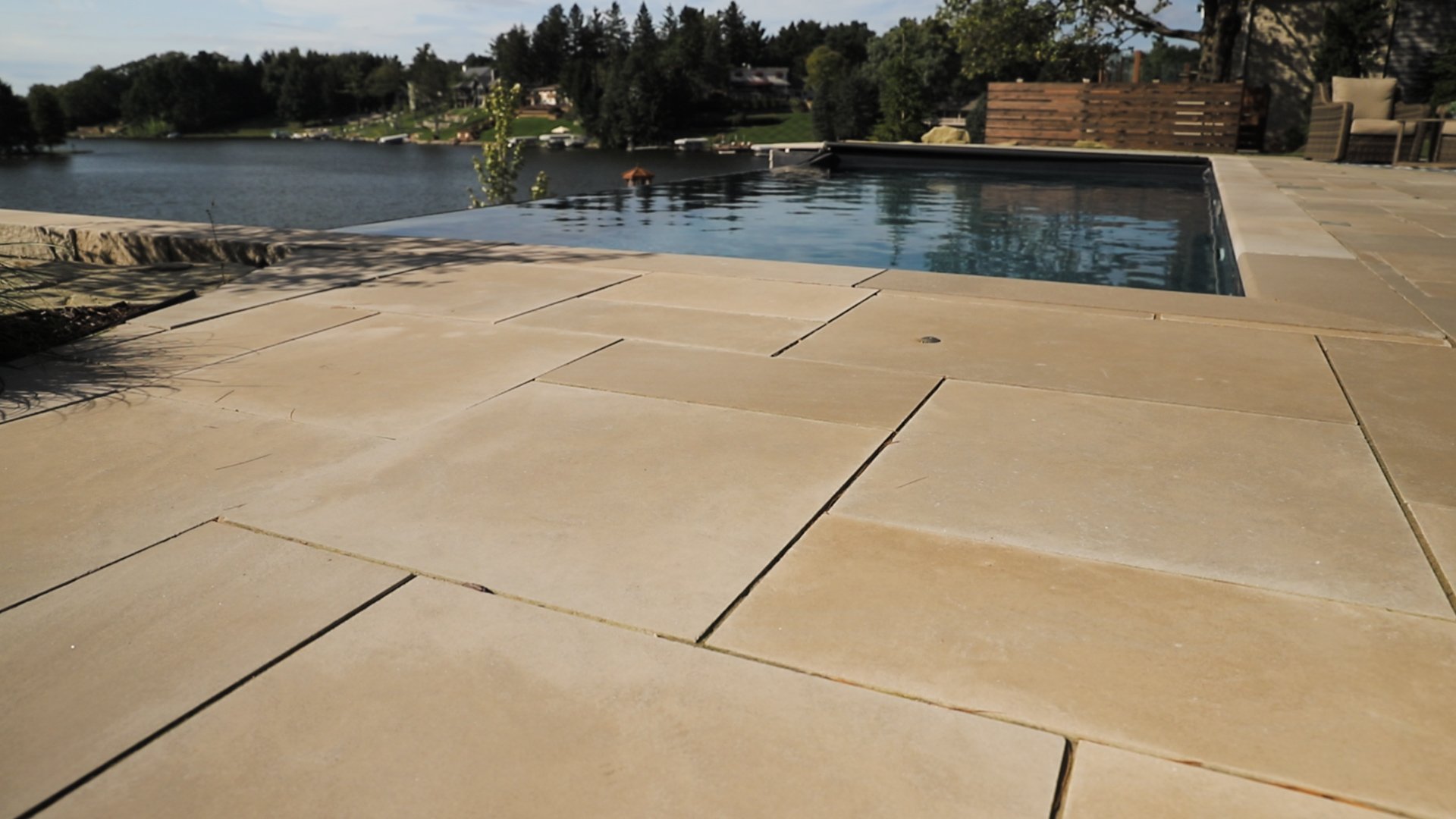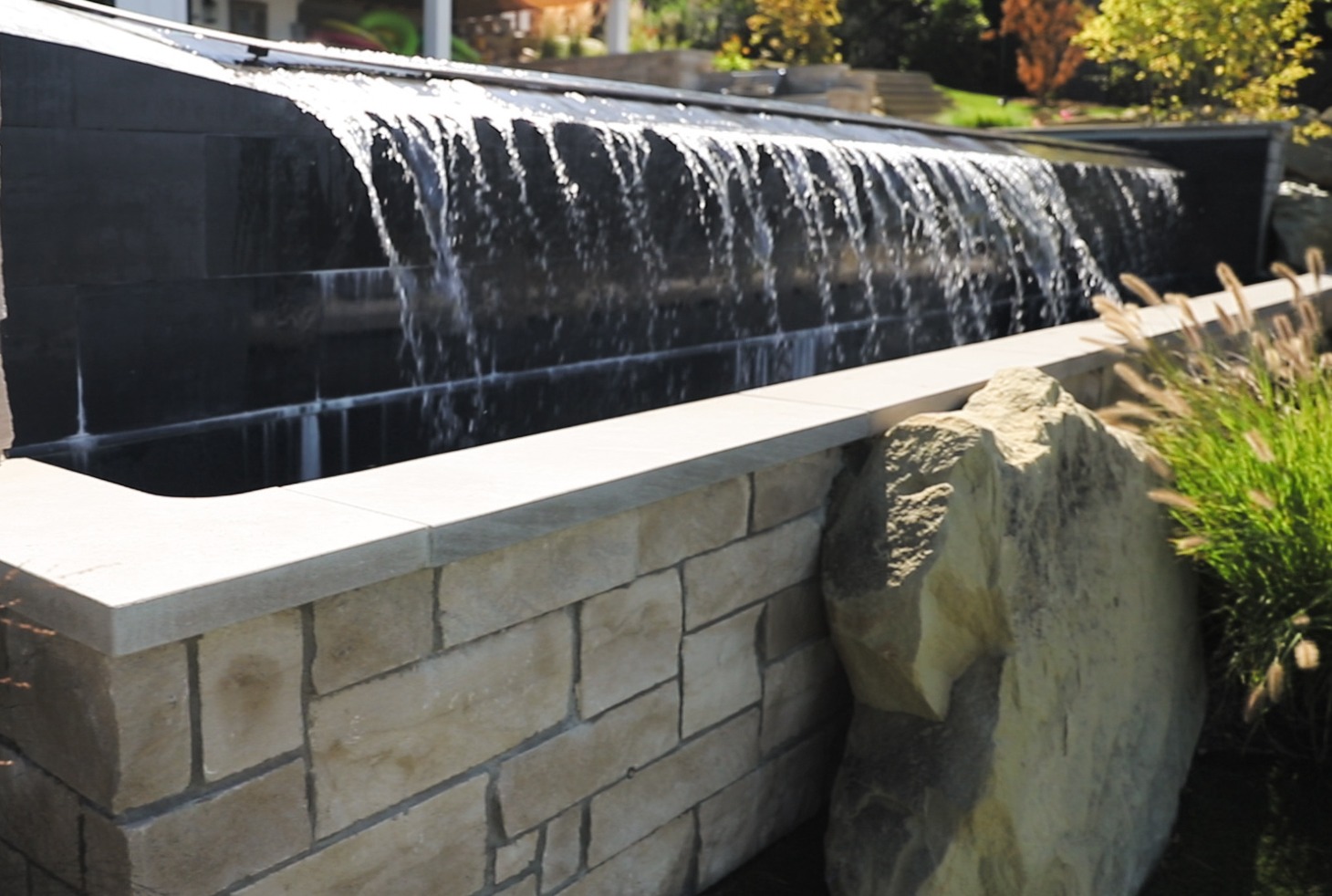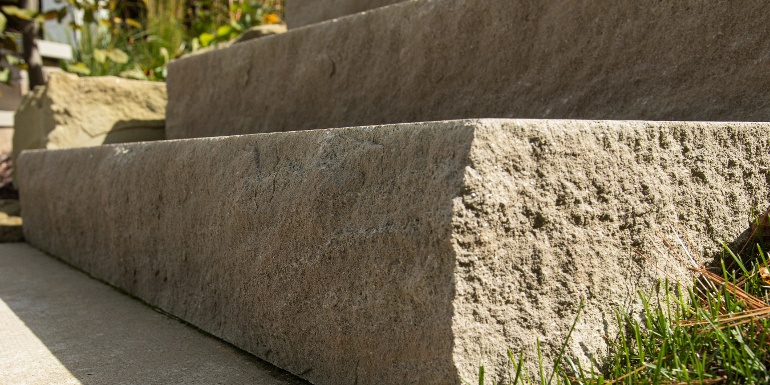In the battle between whether to choose concrete or Indiana Limestone for a hardscape project, the winner just might surprise you (we’re looking at you, limestone).
Let’s get ready to rumble!
Despite the common perception that concrete products offer superior durability and that Indiana Limestone is just too weak for many outdoor jobs, the truth of the matter is that this type of natural stone checks all the marks for holding up over time, and will still look good long after concrete has begun to fade and deteriorate.
So, why should Indiana Limestone be a solid contender for your next landscape job? Let’s go a few rounds and find out:
 These pavers in a three piece pattern will look this good for generations to come. As they wear they'll stay the same tone and texture.
These pavers in a three piece pattern will look this good for generations to come. As they wear they'll stay the same tone and texture.
Natural stone looks the same for decades
A major difference between concrete and natural stone is that stone is the same composition throughout - what you see on the surface is the same as what's on the inside, not a superficial layer added on to a base material. When a concrete paver wears with time and weather, the aggregate is exposed, revealing a rough, chunky surface that loses its original engineered color and texture. Natural stone wears evenly over decades and maintains the same texture and tone.
Concrete is durable, for sure, but its appearance becomes less-than-acceptable over time. Even after a couple of winters, concrete paver surfaces will start breaking down — salting will expose the aggregate and the nice, finished top that mimicked natural stone will be gone. What customer would want to look at that?
You’ve heard the banter between concrete competitors - who has the latest technology to render the best concrete color retention? You can do away with the problem all together and use natural stone. It doesn't have any colorants added to it so it won't fade. No matter what, natural stone is just going to look better as it ages. Concrete will only deteriorate with time and weather.

These pavers were cut with precision saws on the Polycor production line. Their uniform size and thickness means less lippage and a smoother patio surface.
Indiana Limestone is a team player
When it comes to ease of working with a product, Indiana limestone is the clear champ. To get down and dirty, the way Indiana Limestone is produced creates superior tolerances to anything concrete manufacturers can achieve. What does that mean? Contractors aren’t going to have to mess around on site as much or worry about something lining up, making the installation that much quicker.
Concrete products can vary by up to ⅛ of an inch which can result in lippage between pavers, creating trip hazards. That’s the nature of a poured product that undergoes a curing process. Because natural stone products aren't poured into molds but are sawn and gauged instead, the products hold to a tighter tolerance. Thanks to the best technology and equipment, Polycor can tune its line to hold to dimensions within a 1/16 of an inch.

Limestone wall caps and coping can be easily snapped to size on site.
One of the advantages of using Indiana Limestone for landscape walls, caps, coping and edging is its ability to be easily manipulated on site. Limestone can be snapped easily to any length needed and quickly touched up using a brick hammer to restore a nice, chiseled face or sandpapered to a smooth, flat edge.
Contractors using natural stone get a lot more flexibility to cut to size on a job site. No matter how it's cut the grain is the same. Cross-cut a piece of concrete and you see raw, gnarly bits of aggregate. It’s like cutting a ceramic tile from a standard stock size to fit an installation and seeing the exposed, orange edge. That raw edge sticks out. With Indiana Limestone if you have to finish off a cut edge, it’s going to look the same as all the other pieces.
Looking for some muscle? Indiana Limestone brings it every time.
Concrete products are supposed to be 8,000 PSI for paving. Indiana limestone clocks in at 4,000 PSI or better, according to the Indiana Limestone Institute. Does that lower PSI mean anything for hardscapes? Only if you’re building a California freeway (or an airport runway). 4,000 PSI is more than adequate for any residential application. Don’t let the concrete industry let you think that Indiana Limestone isn’t up for any outdoor project.
Limestone goes the distance
The Biltmore Estate. Empire State Building. The Pentagon. What do all of these great American structures have in common? You guessed it: they’re made of limestone.
-1.jpg)
The famed Biltmore Estate in Asheville, NC has been looking good in limestone for 120 years.
In fact, George Vanderbilt had Indiana Limestone delivered directly to the Asheville, NC building site to create the Biltmore’s grand facade in the late Nineteenth Century. It’s estimated that about 5,000 tons of Indiana Limestone was shipped in total from that quarry and 120 years later, the elegant facade continues to greet thousands of visitors each year.
Natural stone is natural stone. Even if it begins to wear away generations from now, Indiana limestone is the same all the way through.
So, let’s face it, Indiana limestone — which came into the ring an unapologetic underdog — has pinned concrete to the mat and showed just what makes a champ in the hardscape arena.
See it for yourself. Get a sample of Indiana Limestone.

